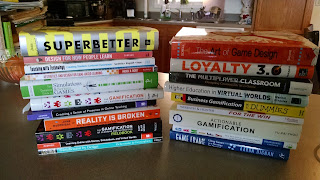This has been a thinking and planning week as we have made some firm decisions that require a little bit of reworking in the course deign...all good and, for me, fun! I love to create, and any time I am given the opportunity to create and try something new, I am all for it. Our decisions, while requiring more tine and creativity on both of our parts, will result in a much better course.
Description
We met Monday after having spent time reading, researching, working on content, and creating tasks. Originally we set up this course to be a typical, module-directed course about Gamification. But that just seemed stale. We wanted a course that actually "walked the walk," a gamified course about using gamification to solve an educational or business problem.A traditional approach, while certainly doable, was just not exciting us. I love to game and have been playing with the idea of creating a game for years, so, why not gamify this course?
Basically, we just had to make the decision - do we gamify or not?
After discussion, we responded soundly with, "We do!"
Since we had already determined the sequence of content, and I had already created most of one module, I decided to begin a narrative for the course, weaving the story into a game. I started by reviewing my previous exploration into the instructional design of gamification (part 1, part 2, part 3), focusing on the aesthetics, particularly the narrative and its components. I reviewed some great resources that I highly recommend to anyone venturing into game design (Dickey 's Aesthetics and Design for Game-Based Learning and Onder 's Storytelling in Level-Based Game Design).
I started a series of introductory narratives, setting them up to award experience points upon completion. Basically,students are beginning a journey through the Land of Gamitopia where they will stop at a series of cities and towns and learn about the various topics, participate in challenges, quests, guild chats, and such. Their first stop will be in the Towne of Histoire which contains all of the history of games. The trick is to weave the narration into assignments along with using game elements...SUCH FUN! I am enjoying this!
On a related note, I assigned names to the various cities, setting up modules as placeholders. As we find research pertaining to each module, we will add it to the module to be used as possible reading assignments or bonus quests .. while keeping in mind the need to individualize for K-12, HIED, and Business.
We have also decided to present the material through the game, having students work through perhaps the first 5-7 weeks of the course, then work on their projects, then return to the game now that they have some experience and explore Law and Ethics of Gamification as well as look to he future.
Feeling
I'm happy with this approach. This simply feels right. We should be modeling what we teach Why teach about gamification when students could experience gamification for themselves? I am comfortable with the topics and the order, and we need to flesh out the content to help us write the narrative and design the plot hooks. Course design feels more fun now.It feels good to finally start applying what I have learned from reading and playing games to designing or own course.
Evaluation
Do we ever accomplish as much as we want to accomplish and to the level that we expect? Although I have started the narrative, I know I will continue to return to it, fleshing it out and making it more continuous. I know I need to do more with the aesthetics, but wanted to start to see how it would weave and what is needed The narrative is still weak and needs more, but this is just the beginning. We need to develop more of the content and let the content help determine the story and the activities.Analysis
We simply need to build content, use the content to design the activities, and the activities to generate the narrative...so build, build, build!Conclusion
Our task for the next week? Build content. Develop activities that support the content. Generate the narrative and aesthetics. Repeat, adjusting as needed.References
Dickey, M. D. (2015). Aesthetics and design for game-based learning. NY: Routledge.Onder, B. (2002). Storytelling in level-based game design. In F. D. Laramee (Ed.) Game-design perspectives (pp. 291-298). Hingham, MA: Charles River Media.





